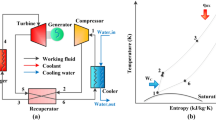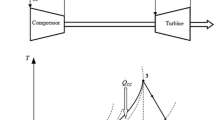Abstract
In order to improve the flexibility and adaptability of micro nuclear power systems, air is considered as an optional working fluid of nuclear Brayton cycle. It has ability to avoid shortage of working fluid under extreme conditions, and ensure the system operating with tight supply. Compared with the traditional open cycles, the closed cycle has advantages of higher cycle efficiency, smaller equipment size and higher power density. Few of closed air power cycle in nuclear power system has been studied by now. In this paper, cycle parameters were analyzed and designed, and optimal cycle performance was compared between cycle constructions.
Four closed air Brayton cycles are proposed and modeled in EBSILON 15.0, including simple regenerative cycle (SRC), intercooling regenerative cycle (IRC), reheat regenerative cycle (RRC) and intercooling-reheat regenerative cycle (IRRC). Thermodynamic analysis of the key parameters is conducted, including pressure ratio, turbine inlet temperature, compressor inlet temperature and pressure. In addition, the genetic algorithm (GA) is applied for multi-parameters optimization for the maximal cycle efficiency.
Result shows that with the increase of pressure ratio, the efficiency of SRC increases firstly and then decreases. With the increase of turbine inlet temperature, the pressure ratio corresponding to the maximal cycle efficiency increases gradually. Specific work gradually increases with pressure ratio. In higher turbine inlet temperature, the rising velocity of specific work is faster. Cycle efficiency increases with compressor inlet pressure, and this trend tend to be slower in high pressure region. With the increasing of compressor inlet pressure, optimal pressure ratio decreases and finally approaches to 2.0. The cycle minimal cycle pressure was selected as 6 MPa. Maximal efficiency and corresponding pressure ratio increase with turbine inlet temperature increasing and decrease with compressor inlet temperature increasing. Comparing with SRC, RRC brings 1.16% cycle efficiency promotion, and IRC presents significant specific work increasing. In cycle efficiency distribution contour map of pressure ratio-middle pressure ratio, design point should be selected in high efficiency area. IRRC reaches 39% maximal cycle efficiency and maximal specific power 0.118 MW/(kg/s) of CABC.
Access this chapter
Tax calculation will be finalised at checkout
Purchases are for personal use only
Similar content being viewed by others
References
Office of Nuclear Energy: What is a Nuclear Microreactor? (2021). https://www.energy.gov/ne/articles/what-nuclear-microreactor
McClure, P., Poston, D., Rao, D.V., Reid, R.: Design of Megawatt Power Level Heat Pipe Reactors. Los Alamos National Laboratory (2015)
Filippone, C., Jordan, K.A.: The Holos Reactor: A Distributable Power Generator with Transportable Subcritical Power Modules. Holos Generators (2017)
Arafat, Y., Wyk, J.V.: eVinciTM micro reactor: our next disruptive technology. Nucl. Plant J. (2019)
Rovense, F., Amelio, M., Scornaienchi, N.M., Ferarro, V.: Performance analysis of a solar-only gas micro turbine, with mass flow control. In: 72nd Conference of the Italian Thermal Machines Engineering Association (2017)
Acknowledgments
This work was financially supported by the Pioneering and Innovative Scientific Program of China National Nuclear Corporation and Operation Fund of Key Laboratory of Nuclear Reactor System Design Technology.
Author information
Authors and Affiliations
Corresponding author
Editor information
Editors and Affiliations
Rights and permissions
Copyright information
© 2023 The Author(s), under exclusive license to Springer Nature Singapore Pte Ltd.
About this paper
Cite this paper
Fang, H. et al. (2023). Thermodynamic Analysis and Optimization of Nuclear Closed Air Brayton Cycle. In: Liu, C. (eds) Proceedings of the 23rd Pacific Basin Nuclear Conference, Volume 3. Springer Proceedings in Physics, vol 285. Springer, Singapore. https://doi.org/10.1007/978-981-19-8899-8_15
Download citation
DOI: https://doi.org/10.1007/978-981-19-8899-8_15
Published:
Publisher Name: Springer, Singapore
Print ISBN: 978-981-19-8898-1
Online ISBN: 978-981-19-8899-8
eBook Packages: Physics and AstronomyPhysics and Astronomy (R0)




